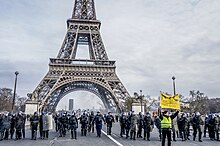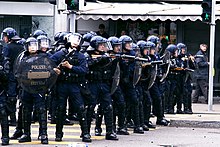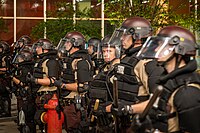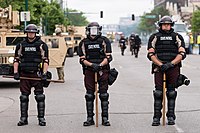|
Riot policeRiot police are police who are organized, deployed, trained or equipped to confront crowds, protests or riots. Riot police may be regular police officers who act in the role of riot police in particular situations, or they may be separate units organized within or in parallel to regular police forces. Riot police are used in a variety of different situations and purposes. They may be employed to control riots as their name suggests, to disperse or control crowds, to maintain public order or discourage criminality, or to protect people or property. The militarization of modern police has brought militaristic riot gear and new technologies that allow for their duties to expand above normal police duties.[1] Riot gearRiot police often use special equipment called riot gear to help protect themselves and for offensive use in riot control. Riot gear typically includes personal armor, batons, tactical shield, riot shields, and riot helmets. Many riot police teams also deploy specialized non-lethal weapons, such as: baton rounds, sponge grenade, pepper spray, tear gas, riot guns, rubber bullets, stun grenades, water cannons, and Long Range Acoustic Devices.[2] Through the 1900s and into the 2000s, riot gear technology has advanced with the help of the militarization of riot police organizations. Some riot gear technology, including tear gas, was originally created for its use in the military, specifically the First World War.[2] In the United States in 1969, it was recorded that the riot police had extensive militarized gear including bulletproof vests, multiple-purpose grenades, water cannons, helicopters, batons, radio communication, barbed wire, police shields, and riot vehicles.[2] In 2017, economic and political protests in Venezuela brought upon a new era of Venezuelan riot police gear with military vehicles that included features like tear gas launchers and water cannons.[2] The military vehicles were used as perimeter defense lines to contain the protests, and provide the riot police with enough power to inhibit the advancing violence. These military vehicles used by riot police around the world are commonly sourced from military product companies including Norinco, a Chinese military product manufacturer.[2] In the United States, the federal 1033 program allows for police departments, including riot police units, to request military equipment for circumstances that have arrived or that may arrive in the future.[1] Because of this program, police militarization has expanded across each state allowing state riot police to receive military style gear similar to that of the Special Weapons and Tactics teams.[1] The police departments that received 1033 program funding are primarily smaller police departments.[1] Riot gear became the key tools for police forces to combat large demonstrations, including political and economic protests and labor demonstrations, that sought change without the explicit consent of the presiding government.[2] Riot police dutiesRiot police are tasked with police operations that require advanced tactics and equipment to control crowds and maintain public order. These duties may differ between riot police organizations in different countries, but they are often similar in that they are tasked with maintaining order that is decided on by the presiding government. In Poland, for example, riot police are used in a variety of different ways including but not limited to:[3]
United States riot policeThe United States has a long history of riot police being used in public events. In the 1950s and 1960s, the Civil Rights Movement and anti-war protests resulted in many instances of large protests across the country. In some cases, these protests would involve clashes between protesters and riot police. The riot police, at this time, did not have as advanced gear and technology, which forced the riot police to have significant face-to-face violent clashes resulting in injuries and deaths of both protesters and police. The 1980s brought in a new era of riot police that intended to use less face-to-face clashes by using more militarized gear and negotiated management. The use of negotiated management sought to improve the riot police's ability to communicate verbally among police and protesters in an attempt to lower violence, increase periods of calm, and improve public views of protest policing.[4] In 1999, the World Trade Organization protests in Seattle disrupted the negotiated management tactics by riot police.[4] The WTO protests went on for days with continuous clashes between protesters and police with tear gas, concussion grenades and riot shields.[5] In August 2014, Michael Brown, an unarmed African-American eighteen-year-old, was shot and killed by police in Ferguson, Missouri. Protests began immediately following the reports his death. The Ferguson Police Department enlisted help from the St. Louis County Police Department to contain the ongoing unrest from the crowd of protesters. The St. Louis County Police Department enacted the county's Code 1000 plan, enabling the department to receive direct assistance from nearby police departments. Riot police from multiple police departments combined in response. For multiple days, these protests were both peaceful and, in some locations of the protests, disorderly. The riot police utilized riot gear including rifles, riot shields, tear gas, non-lethal weapons, and armored vehicles. After the police officer that shot and killed Michael Brown was identified to the public, the protests reignited with more riot police in helmets, face protectors, gas masks, riot batons, shields, and kevlar vests. The riot place were later supported by the Missouri Governor's call for National Guard assistance until the protests continuously diminished.[4] In 2016, protests by groups of indigenous people, including the Standing Rock Sioux tribe, protested the building of the 1,200 mile Dakota Access Pipeline in North Dakota. Large groups of protesters blockaded the construction zones for the pipeline, which prohibited the ability for the DAPL to further expand. Private security were the first to respond, which escalated the protests and created violent clashes between private security personnel and protesters.[6] Following a federal judge's order to allow construction to continue, riot police arrived on the scene. The riot police arrived with armored military vehicles, helmets, face protectors, kevlar vests, shields, and other standard riot gear. Water cannons, pepper spray, and non-lethal weapons were used to disperse protesters and destroy protester encampments on the construction sites.[7] French riot police In 2018 and 2019, France experienced massive protests known as the Yellow Vest Protests. The Yellow Vest Protests were primarily in response to rising costs of living, low wages, and vast inequality between higher and lower economic classes. These protests were immediately met with the French riot police. In some areas of Paris, including Place d'Italie, protesters became violent in response to the police presence. These protesters vandalized private businesses, including banks, and setting fire to police barricades. The riot police responded with standard riot police gear including tear gas, riot batons, and riot shields.[8] In 2023, French police shot and killed a 17-year-old, leading to national protests that required the use of riot police. President Macron, and the French government, repeatedly called to quell the protests. Some Paris suburbs experienced damaged buildings and burning cars on the streets. Throughout France, upwards of 40,000 police officers were dispatched, many of them fitted in riot gear. French riot police used tear gas, riot batons, and riot shields in an attempt to slow down the protests. Approximately 170 police officers were injured during the protests.[9] Quality of life for riot policeThe riot police occupation has been considered one of the more stressful jobs in law enforcement. Riot police are frequently placed on the front lines of violent protests and riots, possibly putting each individual police officer's health and safety at risk. Studies, in recent years, have shown a correlation between higher stress levels among police officers leading to lower quality of life ratings.[10] In 2018, a Turkish study, researching the quality of life in riot police, found that riot police are significantly affected by negative mental health. The research found that roughly 50% of the riot police examined showed clear signs of both anxiety and depression. Furthermore, levels of anger among riot police were high, which was shown in combination with anxiety and depression to lower the quality of life for these officers. It is hypothesized in the research that the lower quality of life indicators could result in more aggressive action by riot police. The research concluded with an argument for developing programs to minimize negative mental health factors in riot police including the use of regular mental health screenings.[10] CriticismsHistorically, riot police have been criticized by labor unions and organized strikes. In the late 1800s and early 1900s, labor unions and picketers were subjected to harsh police crackdowns that involved bouts of police brutality to squash the labor movements. Labor historians have argued that riot police became a strong wing of the government in protecting capital. Industrialization brought in more aggressive police response to labor protests to force workers to abandon their efforts. The ramping up of riot police violence in deterring labor organization caused radicalization and politicization among workers and worker organizations throughout much of Canada and the United States.[11] The recent trend in police militarization across the globe, especially the United States, has brought upon direct criticism from police abolitionist groups. Police abolitionist movements have called for the defunding and replacement of police forces in favor of social programs that support quality of life in people, thus reducing the need for people to commit crimes. Riot police are considered under the police categorization for replacement because of the instances of brutality on protesters in mass protests such as the Ferguson Protests.[12][13] In Cyprus, riot police have come under fire recently for hiding their identities when performing police duties such as crowd control. Cypriot law enforcement has been using helmets and gear to cover their faces and badges in order to remain anonymous when dealing with protests and crowds. Citizens of Cyprus believe that riot police hiding their identities allows them to avoid repercussions for actions they may take during their work. On the other hand, 37% of Cypriot riot police believe that "citizens file complaints against the police for no reason".[14] Riot police in the United States, France, and many other places, have experienced a rise in protests against the police. These protests have been met by riot police with the controversial use of specific militarized riot gear. In the Dakota Access Pipeline protests in North Dakota, riot police used water cannons during freezing temperatures which caused a potentially lethal and dangerous situation.[7] In the George Floyd protests of 2020, riot police used pepper spray, police projectiles, tear gas, among other riot gear resulting in numerous protester injuries.[15] When police escalate the use of force and arrests are made, studies have shown that the results often create more violence.[15] The use of force, sometimes deadly force, is the point of interest for many protests around the world. List of riot police organizations 
See also
References
|

